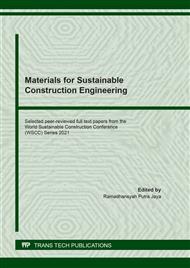p.55
p.67
p.77
p.93
p.103
p.111
p.119
p.127
p.135
Comparison of Recycled Waste Amount for Construction and Demolition (C&D) Waste between Two Apartment Projects
Abstract:
Construction and Demolition (C&D) waste is increasing enormously due to rapid growth of construction industry in developing countries. A few irresponsible contractors dumped illegally the excessive C&D waste in the forest, mangrove swamp, oil palm plantations, roadside and in the sea or lake. However, there are some responsible contractors who carried out recycling practices in the construction project to cut the amount of waste sent to gazette landfills which are approved by local authorities or government. Therefore, this paper is aimed to investigate the total C&D waste amount recycled waste before sending it to designated landfills. This study only focused on four types of C&D waste namely timber, metal, concrete and packaging material. The method that is used for this study is ‘on-site quantification’ based on the volume and gathered ‘recorded recycling amount’ from the project manager and safety officer. This study is conducted at two construction apartments (site I and site II) in Johor Bahru. The data collection was taken weekly for 6 months’ period. The collected data were analyzed using cumulative amount of volume, weight in meters (m3) and percentages. As results, timber was the dominant waste produced at site I while metal waste was highly generated in Site II. About 47% (29.85m3) of total waste produced at site I was timber waste. About 49% (50.39m3) of metal waste generated at site II. There are 36.13m3 of C&D waste recycled at site I and 66.21m3 of C&D waste was recycled at site II. The study found that timber and metal were highly recycled waste materials at both apartments. Finally, a total of 473.86m3 waste recycled in both projects, and this amount save from to be dumped at landfills which is not a suitable hierarchy. This study will create awareness to all construction practitioners, about the needs of recycling practice to minimize the amount of C&D waste send to landfills.
Info:
Periodical:
Pages:
103-110
Citation:
Online since:
March 2022
Keywords:
Price:
Сopyright:
© 2022 Trans Tech Publications Ltd. All Rights Reserved
Share:
Citation:


